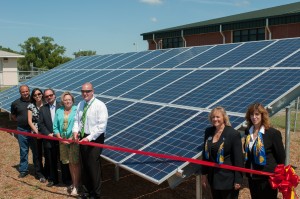By Sherri Shields
COCOA, May 17, 2013 – Students, teachers and the community of Haines City will reap multiple benefits from the new 10,000-watt photovoltaic (PV) system at Haines City High School. The PV system with battery backup will provide emergency power during an outage, reduce daily electricity costs to the school, and serve as a learning resource.

The Florida Solar Energy Center (FSEC), a research institute of the University of Central Florida (UCF), held a dedication ceremony and solar workshop for teachers to celebrate the installation of the 42-panel PV system at Haines City High School on Wednesday, May 15th. Coordinated by UCF’s Florida Solar Energy Center, the system, valued at $85,000, is the 85th PV system installed through the SunSmart Schools Emergency Shelter Program.
In conjunction with the dedication, a professional development workshop gave teachers from Haines City High School, Poinciana Academy of Fine Arts in Osceola County, Bloomingdale High School in Hillsborough County and Montessori World School in Orange County an opportunity to experience hands-on solar activities, showcasing the FSEC curriculum and a companion renewable energy kit. More than 250 teachers have participated in similar workshops, impacting more than 50,000 students statewide.

Not only does the PV system reduce electricity costs by up to $1,500 a year and serve as a generator when a power outage occurs, the system also reports performance data to FSEC; the data will be available on energywhiz.com in June. This site will allow students and teachers to analyze PV system performance data to better understand how the technology works. “We hope we never have to use the system as a generator, and we’re excited about the hand-on learning application for our students and teachers. Being able to see the real-time data that our system produces will be a tremendous resource,” said Stephen Scheloske, assistant principal at Haines City High School.
The success of the program is largely due to strong partnerships between the U.S. Department of Energy, the State of Florida, UCF’s Florida Solar Energy Center, school districts, the Florida solar industry, and utilities. The E-Shelter Program’s initial $10 million in funding was awarded by the U.S. Department of Energy, through the State of Florida’s Department of Agriculture and Consumer Services. As the program gained momentum, however, utility partners – Progress Energy (now Duke Energy) and Tampa Electric (TECO) provided an additional $2 million in funding to expand the program and equip additional schools with PV systems. A total of 105 bi-modal PV systems in 46 school districts are now installed in Florida.
“Certain aspects of the program presented brand new challenges. Installing photovoltaics on schools is not a new concept, but adding batteries is,” said SunSmart Program Manager Susan Schleith. The battery component increased the complexity of the installations significantly. An unprecedented number of tradespeople were involved to make the program a success. It is estimated that more than 60 different companies in Florida were involved in some aspect of this program. “We all should be proud of this accomplishment that will benefit Florida now and for generations to come,” added Schleith.
For more information about the SunSmart E-Shelter Program, contact Susan T. Schleith at (321) 638–1017, susan@fsec.ucf.edu or Sherri Shields at (321) 638-1019, sherri@fsec.ucf.edu.
###
50 Years of Achievement: The University of Central Florida, the nation’s second-largest university with nearly 60,000 students, is celebrating its 50th anniversary in 2013. UCF has grown in size, quality, diversity and reputation, and today the university offers more than 200 degree programs at its main campus in Orlando and more than a dozen other locations. Known as America’s leading partnership university, UCF is an economic engine attracting and supporting industries vital to the region’s success now and into the future. For more information, visit http://today.ucf.edu.
Yes its very important specially in present circumstances where world is under the environmental pollution that we save not only the fossil fuels but also overcome the pollution by using such technologies